All guidebooks and people who have visited Jaisalmer rave about its beautiful golden fort, the grand havelis, camel rides, sunset among the dunes, its Jain temples, cenotaphs, etc. But none (at least I haven’t come across any) talk about the unique wall art of Jaisalmer. When I saw the first one (see photo below), my reaction was one of horror: how could something like this be painted on the walls of an old haveli?
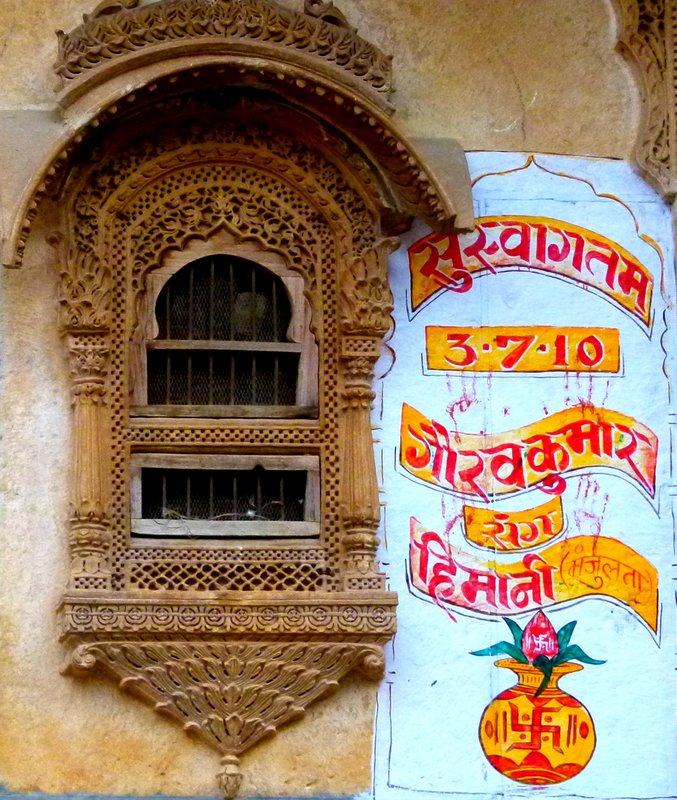 Then I saw more of these and then some more. In fact, almost every house in Jaisalmer has such announcements painted near the entrance. The announcements are of weddings, upanayan ceremonies, housewarming ceremonies… And realised that this is a custom, a tradition in Jaisalmer and one that is unique to this city, as its residents kept telling me. Almost all these “announcements” have auspicious symbols accompanying it like the kalash, the swastika, and Ganpati.
Then I saw more of these and then some more. In fact, almost every house in Jaisalmer has such announcements painted near the entrance. The announcements are of weddings, upanayan ceremonies, housewarming ceremonies… And realised that this is a custom, a tradition in Jaisalmer and one that is unique to this city, as its residents kept telling me. Almost all these “announcements” have auspicious symbols accompanying it like the kalash, the swastika, and Ganpati.
A small selection of Jaisalmer’s wall art in Jaisalmer is presented below:

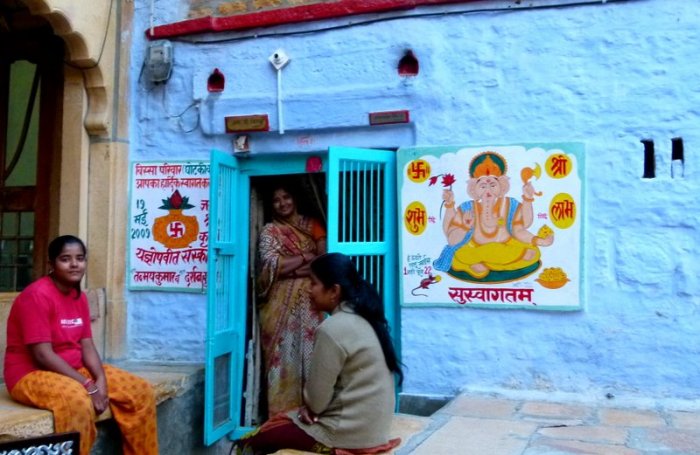

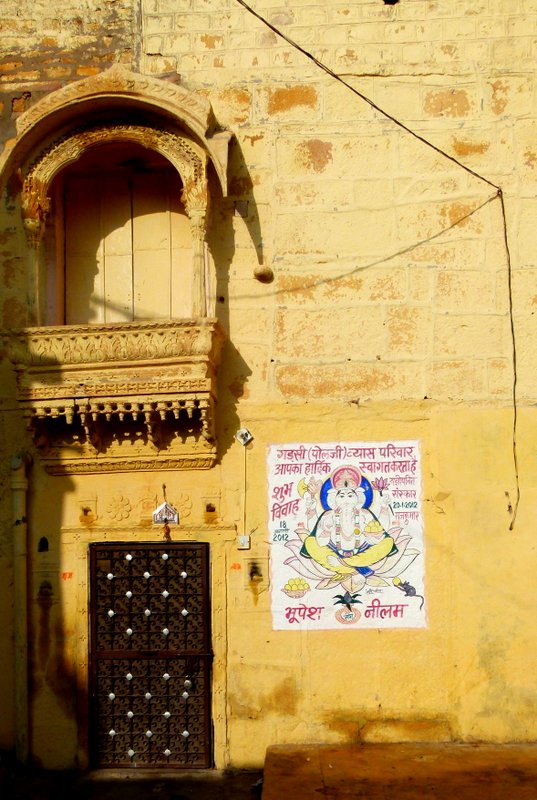
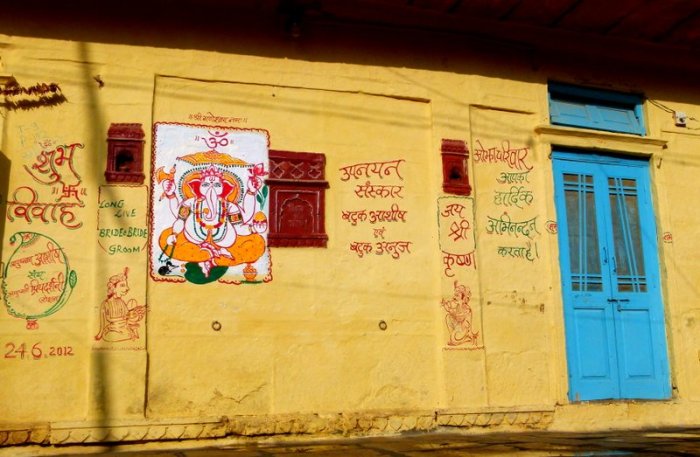 I saw only one wall art in Jaisalmer that was not an announcement — this stunning painting of Hanuman outside the Laxminarayan temple.
I saw only one wall art in Jaisalmer that was not an announcement — this stunning painting of Hanuman outside the Laxminarayan temple.
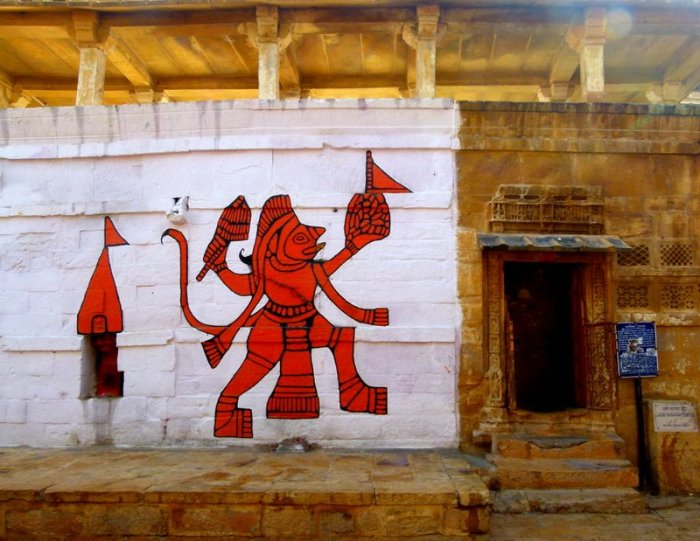 Wall art, street art, graffiti … are a completely different genre of artistic expression and every city has it in some form or the other. And it is often this expression of art that differentiates one city from another. Jaisalmer’s wall art is part of a tradition that has been around for centuries and one that contributes to the uniqueness of the city. Once I had gotten over my initial horror of what I thought was “defacement”, I had a good time reading the wall art and trying to imagine the people behind the announcements.
Wall art, street art, graffiti … are a completely different genre of artistic expression and every city has it in some form or the other. And it is often this expression of art that differentiates one city from another. Jaisalmer’s wall art is part of a tradition that has been around for centuries and one that contributes to the uniqueness of the city. Once I had gotten over my initial horror of what I thought was “defacement”, I had a good time reading the wall art and trying to imagine the people behind the announcements.
I was in Jaisalmer earlier this year in February year as part of a trip through various places in Rajasthan. And wished I could have spent more time there. And guess what, my wish is coming through and I leave for Jaisalmer tomorrow. Watch this space for more 😀

priceless pics:)
LikeLike
Thanks, Vishal. Glad you liked them.
LikeLike
Interesting captures!
http://rajniranjandas.blogspot.in/2013/07/the-plains.html
LikeLike
Thank you, Niranjan 🙂
LikeLike
Trust you to find something out of the way that lesser tourists would miss or dismiss 😀 Perhaps this is a way of perpetuating the union of two members of a family. I wish you could have asked some of the residents about this unique practice and hope you will do it this time round. The hanuman painting is indeed stunning. Looking forward to reading all the juicy touristy tidbits left out by the tourist brochures! Have a great trip 🙂
LikeLike
This was the open invitation for the event as there was no concept of invitation cards. The announcements would come in a few weeks before the vent and that was how people would know and come for the wedding/upanayan/housewarming. I loved the Hanuman painting too 🙂
LikeLike
only you in the whole wide world, can notice such lovely things…I would have just walked past without caring about it :):) Amazing photos 🙂
LikeLike
Thanks, RM. Only you can say such lovely words. And no, you would not have missed these announcements. They are everywhere 🙂
LikeLike
Lovely pic, Sudha! 🙂
Similar wall art is common in Gujarat too, more in rural dwellings. They are mostly pictures of gods and goddesses, but stunning and very much based on local beliefs. Another kind, as you have mentioned, consist of wedding and upanayan announcements. Almost all of the wedding announcements there also contain the hand prints of the new bride and groom. It is a way of welcoming the bride into the groom’s family. It is a custom to have the new bride pray outside the husband’s house, and for both of them to cross the threshold together, after placing their handprints on the outside wall. The tradition is fast disappearing in urban areas, thanks to most people living in apartments now.
LikeLike
I have seen the ones in Gujarat which are similar to, but not the same as the one in Rajasthan. The bride’s handprints for one are missing. But the major difference is the reason for these announcements: there is no concept of invitation cards and this announcement was the invitation card for the town or village. Considering the strong ties of the people in the Fort this invitation was more than enough. Imagine painting something like this in a city and the undesirable it would attract ! 🙂
LikeLike
I love these walls… they have their own beauty and its like it was meant for Rajasthan only.
And fabulous captures. 🙂
LikeLike
Thank you, Namrata. They are quite something, aren’t they? 🙂
LikeLike
You really have an eye for the unusual Sudha!
LikeLike
Thank you, Suresh. Everyone’s perspective is unique, and I guess this is mine. 🙂
LikeLike
Very nice shots…:)
LikeLike
Thank you. Ajeeth. I really enjoyed going through all the wall art announcements and photographing them.
LikeLike
Your welcome… Bet you did…
LikeLike
Sudha can you believe it? I have also clicked the first invitation. Lovely collection!
LikeLike
Great to see you here, Mridula. Welcome 🙂
This was the first “announcement” I saw at Jaisalmer and painted at the entrance of the Nathmal Diwan ki Haveli, and was quite horrified to see sometething like this painted so casually. It is only as I walked around and saw more of these that I realised what it was all about.
LikeLike
Hi! Fun catching up again. I was swamped. You’re always up to something interesting.
LikeLike
Great to see you here again, Shovon. And life is always interesting, sometimes more, sometimes less, but always. 🙂
LikeLike
Really unique pictures – they are heritages
LikeLike
Welcome here, Uma and thank you so much for stopping by and commenting. These announcements are really eye-catching aren’t they?
LikeLike
Great post like this must be highly recommended. It is so nice to read such wonderful blog. Thanks for sharing!
LikeLike
Glad you liked the post, Kebhari. Do keep visiting 🙂
LikeLike
I am wondering do they have announcements of people’s passing as well? It would be one way to commemorate a dear one’s life – with unique wall art.
LikeLike
No, they do not have announcements of people passing away. Maybe it is considered inauspicious to put up announcements of deaths. Hmm… something to think about, Meera. Thanks !
LikeLike
lovely captures, Sudha!!! i remember seeing them on my visit to jaisalmer too. however, this custom of painting marriage announcements on walls isnt unique to jaisalmer. it is done in other parts of india too,but we rarely notice them because the walls are rarely as beautifully maintained. i saw these in interior maharashtra too… dont remember where exactly, but i think somewhere near nanded. unfortunately, i didnt think of capturing them on camera then 😦 it works beautifully since everyone in the town gets to hear of the wedding or event and turns up, even without a formal invite. also, if someone knows anything about the bride or groom, they can come forward with the info. good idea, right? and the walls will at least be free of spit!!!
LikeLike
In her comment, even TGND has mentioned that these announcements are not unique to Jaisalmer and that she has seen them in Gujarat. I, for one, have not seen such prominent announcements anywhere during my travels, not even in other parts of Rajasthan. When I was in Jaisalmer this time, I was told that there is no concept of invitation cards and these announcements are the invitation cards for the people of the city 🙂
LikeLike
Yes, beautifully painted invitations – especially the details of Ganesh and the lady in the wedding invitations. They remind me of the old way of advertising film banners/haoardings when they used to be painted by skilled artisans – a dying art today.
The one on Hanuman is really lovely.
LikeLike
The one on Hanuman stands out as it is so different in style from the others in Jaisalmer and also form the traditional depictions. This one remains my favourite 🙂
LikeLike
Very nice, i love those drawings!
LikeLike
Thank you very much.
LikeLike
Yes, loved them too when I was in Jaisalmer..Hope you saw the Havelis..they are magnificent!
LikeLike
Welcome here, Kalpana. Yes, I visited the grand havelis too (and wrote about them as well). In fact, the first wall art is taken from the Nathmal Diwan ki Haveli – it was painted right at the entrance. Here was the guide telling us that the haveli was a heritage structure and there I was getting shocked seeing the ‘recent’ announcement. 🙂
LikeLike
Hi
Enjoyed reading your blog. Going through all your pieces on Karnataka, Rajasthan, Very nicely written and photographed. I had gone to Jaisalmer last year and tried to capture some of the quirky wall art too. Saw similar patterns in Udaipur
http://lensdynamic.blogspot.in/2014/10/jaisalmer-golden-city.html
http://lensdynamic.blogspot.in/2013/07/udaipur-lake-city.html?view=timeslide
LikeLike